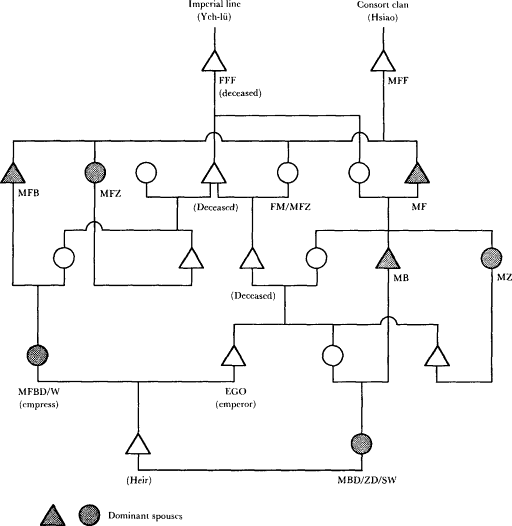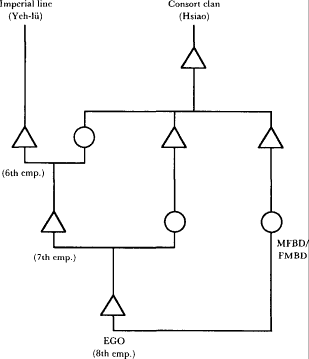The Ch'i-tan Liao
Whereas early Wei marriage strategy focused on protecting the throne and paternal kin from the ambitions of powerful outside interest groups, Liao (A.D. 916-1122) marriages were designed to minimize the dangers posed by
the emperor's male agnates. The system grew out of the support given to the founder of the regime by his wife and her family against other tribal leaders and, more important, against the founder's uncles and brothers, who refused to relinquish their traditional leadership rights. In this system, princes of the blood who were only distantly or remotely related to the throne were more trusted than close male agnates. Accordingly, the latter were given mainly honorary titles and nonfunctional posts associated with the shell of the old political order. As reward for their support in helping to institute the new monarchical and centralized system of government, the family of the first empress (an outsider in relation to the old power structure) was given exclusive rights to marriage relations with the throne and a hereditary lien on key posts in the newly developing system of administration.
In the mature Liao marriage system, all branches of the imperial house (the Yeh-lü) as well as those of the consort clan (the Hsiao) were ranked according to degree of kinship with the founding emperor and empress. The highest-ranking branches of the ruling family (the emperor and his close relatives) married into those of the consort clan and vice-versa. In this way, the ruler was supported not only by his mother and her uncles and brothers (who doubled as senior officials of the outer court), as in the Chinese system, but also by his mother's female kin—her sisters and nieces—who doubled as consorts for his uncles (FB), brothers, and nephews (BS). Here, cross-generational alliance flourished, with members of the consort clan marrying down into younger generations of the imperial house, all of which increased the likelihood that the empress's sisters and nieces would be able to control their husbands and thus help to protect the ruling line from the threat of armed revolt or usurpation by close paternal kin (figure 2.4).
The Liao system, then, was almost a parody of that of the Chinese. Ranking within the harem was determined by the political status of the woman's male kin, and the status of her male kin was determined by social rank defined according to blood ties with the founding empress and current ruler. The correlation of social status, selection for office, and provision of spouses for the royal house was thus much higher than ever intended or seen under any Chinese regime. This is not to say that there was no political and social mobility. Indeed, the middle Liao period saw considerable upward mobility as the throne attempted to weaken the power of relatives of the first empress by broadening the base of the consort clan: here, the new rules of surname exogamy, repetitive marriage-exchange, and hereditary rights to office were circumvented by the simple device of surname adoption; that is, by using the steppe practice of fictive kinship to integrate outsiders into the political system. The same device was later taken up by the consort clan as a means of incorporating its followers into the system. It was only after the system was revamped in the latter part of the regime (1020s) that genuine blood ties with the founding unit were stressed.
Although most Liao rulers married maternal cousins (MBD), distinctions

Fig. 2.4.
Cross-generational marriage: Liao
such as MBD and FZD, relevant to the Chinese model, are less applicable because the system of exchange meant that a wife who was MBD might also be FZD. Cross-generational alliances complicated the situation. The eighth ruler, for example, married a woman who was his mother's paternal cousin (MFBD) and his father's maternal cousin (FMBD) (figure 2.5). Although Liao rulers could marry their maternal aunts (MZ) as well as daughters of the mother's or grandmother's brother (MBD or FMBD), they could not,

Fig. 2.5.
Cross-generational marriage with MFBD/FMBD in late Liao
despite the high status of maternal aunts and cousins, take the female offspring of such women into the imperial harem (MZD). Liao practice here differed from China's because such offspring always carried the surname of the imperial house (Yeh-lü). This explains why power held by the empress's aunts and sisters did not pass to their offspring (although it did reappear in the following generation through the female line). For males of the consort clan, political status initially passed to both male and female offspring but from there was transmitted only through the male line. In short, all members of the consort clan, whatever their gender, tended to have more power than their spouses, including the emperor himself. Because the status of the empress dowager extended to her close relatives regardless of gender, the normal gender inequality between husband and wife was reversed, not for the emperor's sisters as in the Chinese model, but for those of the empress and empress dowager. The military authority assumed by these women in times of crisis (see Wittfogel and Feng 1949:200, 557) was a symptom of this condition.
In theory, the Liao system of marriage exchange should ultimately have
incorporated the consort clan into the imperial house to such an extent that all divergent interests between it, the throne, and paternal kin would disappear. The system favored the consort clan, however, more than it did the throne. Even in early Liao, the emperor was in danger of being overshadowed by members of the consort clan. Action taken to redress this situation was short lived, ending in the fourth reign with the emperor's personal withdrawal from government in a manner similar to that seen in the late Ming. In the latter part of Liao, however, the authority of the throne was protected to some extent by factionalism within the consort clan as wives of one generation battled with those of the next, and as barren empresses struggled to hold their place in the system against fertile concubines. In effect, the various branches of the consort clan began to behave in the same manner as competing generations of wifely and maternal kin in the native Chinese state.